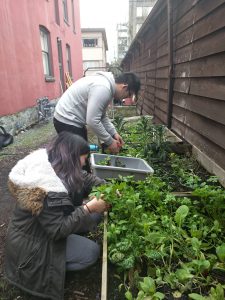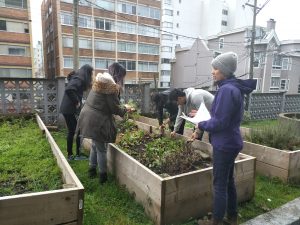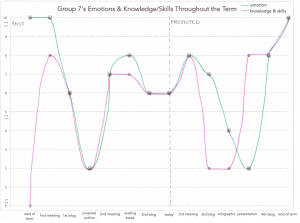Introduction
For the past 3 months, we have worked very closely with Joey and learned more about the influence of urban farming on the West End community. Prior to the beginning our project, we did not realize that community food insecurity existed to the extent that it does in the West End, as we stereotyped this area to contain mostly well-off, middle to upper-class residents. After spending several hours working at Gordon Neighbourhood House, we gained insight on how the GNH’s several food initiatives contribute to alleviating this insecurity. As our group members come from a wide range of backgrounds, we all found it very interesting to learn about urban farming and crop planning. We learned to appreciate the logistics and considerations that go into creating a successful crop plan that maximizes the yield and quality of healthy, fresh produce for the community. We shared our experiences with the LFS 350 students and faculty, as well as other community partners on Monday through our infographics presentation in order to promote the understanding of how a crop plan is designed for urban farming. With our newfound knowledge, we can all start growing produce in our own backyard!

We enjoyed urban farming!
What
A moment of significance that recently occurred in our group was when we received feedback from our professor, Will, about the infographic we designed for our final presentation. Initially, we put a lot of focus on how we designed our crop plan and the ways it contributes to community food security, rather than providing context about GNH and the West End. We were also repetitive with our take-home messages, restating our methods for designing the crop plans instead of putting focus on why crop plans were important in achieving our objectives. Will allowed us to realize that the crop plans were meant to help the GNH maximize crop yields, which in turn allowed the GNH to address community food security in the West End. As we didn’t initially make that connection, it was a bit difficult for us to make the direct link between crop plan to community food security, and our initial infographic was rather vague and unfocused.
So what
Our moment of significance gave us a lot of insight as to how our community project actually fits within the concepts and discussions that we’ve had in the lectures this term. Having just completed our tasks for the project, our group was very excited about our work and the future for the GNH urban farm plots, and by focusing on communicating this, we were distracted from our overall message and goals. We had to change our focus to how our project contributed to community food security rather than discussing the details about how we went about completing our project and the final results of our plans. Having spent hours and hours on the project with Joey discussing the crop plans in great detail, it started to feel as though we were becoming a broken record, and we began to forget that the other students in our class had been working on completely different projects. The students and faculty that we presented to likely would not know much about the GNH or the West End, nor would they understand the concepts we were explaining in the same depth that we did. Will’s feedback urged us to think about what was most important in our process and accomplishments by reminding us to return to our original objectives, as well as what effects we hoped our actions would have on the GNH and the surrounding community. We needed to pare down what we wanted to express and decide what was most important to discuss, finding a succinct and eloquent way to do so.
Our moment of significance reminded us to take a step back from the project, and although at first our project did not seem to have clear connections with the concepts we were learning about in lecture, it forced us to think critically and make larger associations between sustainable crop planning and the concepts of food justice and community food security. By providing more context on the GNH, as well as how our communication with Joey helped us design our crop plans, we were more effective in helping the audience understand how our crop planning project would contribute to improving community food security.
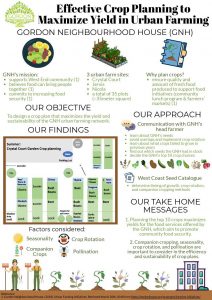
The infographic on our crop plan project
Struggling through the process of making our infographics clearer and more succinct was integral to helping our group find the true connections between lecture concepts and our community project. In a Ted Talk, Tim Harford (2016) discusses that while it can often feel as though messy problems are simply obstacles standing in the way of our success, we don’t realize that this uncertainty can actually make our problem-solving skills more robust and our ideas more creative. Therefore, we can appreciate the challenges that we had to face while working on our infographic, and we believe that it gave us a good opportunity to reflect on our original project objective. It also taught us how to better deliver our experiences and knowledge to a general audience more effectively.
Another problem that we encountered was trying to decide what concepts to prioritize in our infographic, since we wanted to present our ideas in a concise way. Our group members had different perspectives regarding this problem (e.g. some people wanted to introduce the West End community and its food security while others wanted to focus more on the GNH itself). Even though we had to overcome the disagreement and communicate to reach a consensus, this process allowed us to appreciate diversity. Diversity helped us view the problem from different perspectives and how we can improve the quality of our content by collaborating and incorporating different ideas. Furthermore, as we considered the perspectives of the other LFS 350 students and faculty members, we realized that we needed to simplify our presentation and avoid speaking in too much detail, since they did not have as much insight or perspective into the topic as we did. By including the diverse perspectives of our group members and considering the perspectives of our audience, we were able to create a better product. This is just like what Katherine Phillips mentioned in her article, How Diversity Makes us Smarter. “Diversity works by promoting hard work and creativity; the pain associated with diversity can be thought of as the pain of exercise” (Phillips, 2014).
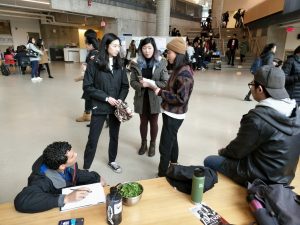
Practicing our presentation in Nest
Now what
Since the very beginning of our project, our group had trouble making strong connections between crop planning and community food security. We tried to develop coherent linkages to the course materials in past blog assignments, but we failed to look at the bigger picture and include the context of the GNH’s role in the West End community. Receiving feedback from Will helped shift our focus back into the right direction, allowing us to be confident and prepared for writing our final project report. Moving forward, we will use this feedback and advice to maintain our focus on the most important aspects of our project. Our final report must critically analyze the connections between food, health, and the environment within food security discourse, and how food insecurity can be addressed by interdisciplinary efforts. Hence, it requires that we understand and portray the connection between our project within broader food system theories. In order to achieve this goal and write a successful and comprehensive report, it is important that we take Will’s advice into consideration, as well as the questions that we received during our infographic presentation. This will allow us to communicate the most important aspects of our project, our objectives and the broader food systems. We were faced with confusion about our project throughout the semester since our project seemed to be different from other groups’, but Joey was truly integral in helping us gain understanding and insight on the concepts. We plan to maintain contact with Joey, and maybe even volunteer during the upcoming growing season. It would be incredible to see how our project is actually being carried out and contributing to the organization.
Conclusion
In conclusion, this was a very interesting project to work on for this course, and we are sad to see it come to an end. Our group comes from a very diverse range of academic backgrounds, and this was helpful because it allowed us to integrate different points of views in the way that we approached the challenges we encountered throughout the term. We definitely faced some moments of uncertainty, and at times, it was frustrating because we were struggling to find ways to connect our project with the course content which made it difficult to understand the purpose of our project. For future students who are coming into a similar project like this one, we would like to advise them to come up with questions regarding the connections between the project and course materials prior to coming to each class. Through these questions, they are able to consult with the TA or the instructor to ensure that they have the right focus when developing the proposal or the infographics.
Our group greatly appreciates the support and input that our head farmer, Joey, provided us. We definitely all agree that this project would have been much more difficult and taken a very different direction without her help. We have grown our understanding regarding community gardens and how they can be utilized (as GNH does) to supply food for other affordable food initiatives within a community to improve community food security. After finishing the project, the next step for us is to take the valuable knowledge of crop planning as well as our understanding of community food security and food justice to help promote more food initiatives to benefit more communities and people. The next step for GNH is to implement the crop plan, but also willing to alter the plans as they seem fit as unpredictable problems may arise during the growing season.
Overall, giving our final presentation to the faculty and other students was a pivotal moment for all of us. We really enjoyed working with the GNH for the past few months, and will keep these memories and experiences with us for the rest of our lives.
References
Harford, T. (2016, Jan 11). Tim Harford: How messy problems can inspire creativity [Video file]. Retrieved from https://www.ted.com/talks/tim_harford_how_messy_problems_can_inspire_creativity
Phillips, K. (2014, October 1). How Diversity Makes us Smarter. Retrieved from https://www.scientificamerican.com/article/how-diversity-makes-us-smarter/

